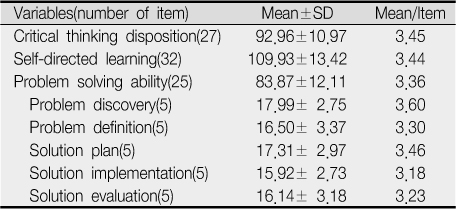1Instructor, Department of Nursing, Gwang-Ju Health College University, Korea.
Copyright © 2010 Korean Academy of Nursing Administration


Characteristics of subjects (n=119)
Problem solving ability, critical thinking disposition, and self-directed learning of subjects (n=119)
The correlations of age, critical thinking disposition, self-directed learning and problem solving ability of subjects (n=119)
*p< .05, **p< .01, ***p< .001
Contributing factors of problem solving ability (n=119)
*p< .05, **p< .01, ***p< .001